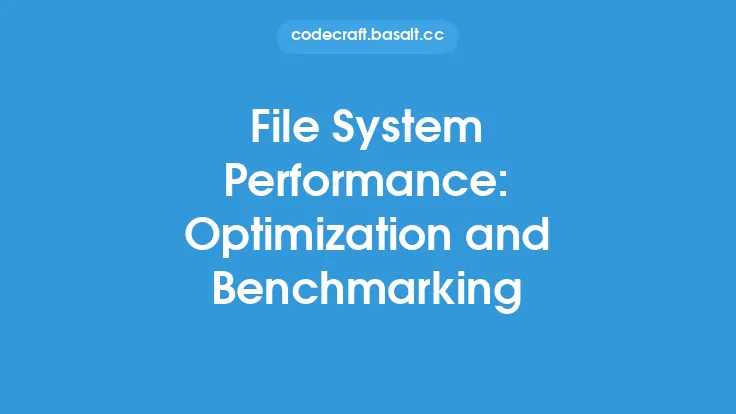System calls are the primary interface between user space applications and the kernel, allowing programs to request services from the operating system. However, system calls can be expensive in terms of performance, as they require a context switch from user mode to kernel mode, which can lead to significant overhead. To mitigate this overhead, various system call optimization techniques have been developed to improve performance and efficiency. In this article, we will delve into the details of these techniques, exploring their benefits, trade-offs, and implementation considerations.
Introduction to System Call Optimization
System call optimization is crucial for achieving high-performance and efficient system design. The goal of system call optimization is to minimize the overhead associated with system calls, reducing the number of context switches, and improving the overall throughput of the system. This can be achieved through various techniques, including caching, batching, and asynchronous processing. By optimizing system calls, developers can improve the responsiveness of their applications, reduce latency, and increase overall system performance.
Caching and Buffering Techniques
Caching and buffering are essential techniques for optimizing system calls. By caching frequently accessed data, applications can reduce the number of system calls required to access that data, minimizing the overhead associated with context switches. Buffering, on the other hand, involves storing data in a temporary buffer before writing it to disk or sending it over a network. This technique can help reduce the number of system calls required for I/O operations, improving overall system performance. For example, the Linux kernel uses a caching mechanism called the page cache to store frequently accessed file data, reducing the number of disk I/O operations required to access that data.
Batching and Grouping Techniques
Batching and grouping techniques involve grouping multiple system calls together, reducing the overhead associated with individual system calls. This technique is particularly useful for I/O operations, where multiple requests can be batched together and processed in a single system call. For example, the Linux kernel provides a system call called `readv` and `writev`, which allow multiple buffers to be read or written in a single system call, reducing the overhead associated with individual `read` and `write` system calls.
Asynchronous Processing Techniques
Asynchronous processing techniques involve processing system calls in the background, allowing the application to continue executing without waiting for the system call to complete. This technique is particularly useful for I/O operations, where the application can continue executing while waiting for the I/O operation to complete. For example, the Linux kernel provides a system call called `aio_read` and `aio_write`, which allow asynchronous I/O operations to be performed, improving overall system performance and responsiveness.
System Call Interface Optimization
The system call interface can also be optimized to improve performance and efficiency. This involves optimizing the system call API, reducing the number of system calls required to perform a particular task, and improving the overall design of the system call interface. For example, the Linux kernel provides a system call called `syscall`, which allows applications to invoke system calls using a single interface, reducing the overhead associated with individual system calls.
Compiler and Runtime Optimization
Compiler and runtime optimization techniques can also be used to optimize system calls. This involves optimizing the compiler to generate efficient code, reducing the overhead associated with system calls, and optimizing the runtime environment to improve overall system performance. For example, the Linux kernel provides a feature called `syscall wrappers`, which allows the compiler to generate optimized code for system calls, reducing the overhead associated with individual system calls.
Hardware-Assisted Optimization
Hardware-assisted optimization techniques involve using specialized hardware to optimize system calls. This includes using hardware accelerators, such as graphics processing units (GPUs) and tensor processing units (TPUs), to accelerate system calls, and using specialized instructions, such as SIMD and SIMD-like instructions, to improve overall system performance. For example, the Linux kernel provides a feature called `iommu`, which allows the kernel to use hardware accelerators to optimize I/O operations, improving overall system performance and efficiency.
Best Practices for System Call Optimization
To optimize system calls effectively, developers should follow best practices, including minimizing the number of system calls, using caching and buffering techniques, and optimizing the system call interface. Developers should also consider using asynchronous processing techniques, compiler and runtime optimization, and hardware-assisted optimization to improve overall system performance and efficiency. Additionally, developers should profile their applications to identify performance bottlenecks and optimize system calls accordingly.
Conclusion
System call optimization is a crucial aspect of system design, allowing developers to improve performance, efficiency, and responsiveness. By using techniques such as caching, batching, asynchronous processing, and hardware-assisted optimization, developers can minimize the overhead associated with system calls, improving overall system performance. By following best practices and considering the trade-offs and implementation considerations, developers can optimize system calls effectively, achieving high-performance and efficient system design.





